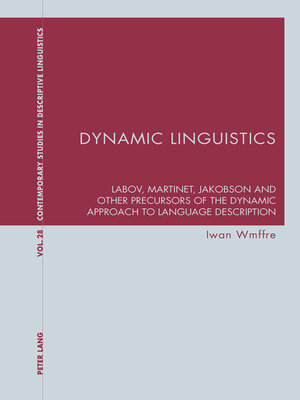Dynamic Linguistics
ebook ∣ Labov, Martinet, Jakobson and other Precursors of the Dynamic Approach to Language Description · Contemporary Studies In Descriptive Linguistics
By Karl Bernhardt

Sign up to save your library
With an OverDrive account, you can save your favorite libraries for at-a-glance information about availability. Find out more about OverDrive accounts.
Find this title in Libby, the library reading app by OverDrive.



Search for a digital library with this title
Title found at these libraries:
| Library Name | Distance |
|---|---|
| Loading... |
Analysis of language as a combination of both a structural and a lexical component overlooks a third all-encompassing aspect: dynamics. Dynamic Linguistics approaches the description of the complex phenomenon that is human language by focusing on this important but often neglected aspect.
This book charts the belated recognition of the importance of dynamic synchrony in twentieth-century linguistics and discusses two other key concepts in some detail: speech community and language structure. Because of their vital role in the development of a dynamic approach to linguistics, the three linguists William Labov, André Martinet and Roman Jakobson are featured, in particular Martinet in whose later writings – neglected in the English-speaking world – the fullest appreciation of the dynamics of language to date are found. A sustained attempt is also made to chronicle precursors, between the nineteenth century and the 1970s, who provided inspiration for these three scholars in the development of a dynamic approach to linguistic description and analysis.
The dynamic approach to linguistics is intended to help consolidate functional structuralists, geolinguists, sociolinguists and all other empirically minded linguists within a broader theoretical framework as well as playing a part in reversing the overformalism of the simplistic structuralist framework which has dominated, and continues to dominate, present-day linguistic description.
This book charts the belated recognition of the importance of dynamic synchrony in twentieth-century linguistics and discusses two other key concepts in some detail: speech community and language structure. Because of their vital role in the development of a dynamic approach to linguistics, the three linguists William Labov, André Martinet and Roman Jakobson are featured, in particular Martinet in whose later writings – neglected in the English-speaking world – the fullest appreciation of the dynamics of language to date are found. A sustained attempt is also made to chronicle precursors, between the nineteenth century and the 1970s, who provided inspiration for these three scholars in the development of a dynamic approach to linguistic description and analysis.
The dynamic approach to linguistics is intended to help consolidate functional structuralists, geolinguists, sociolinguists and all other empirically minded linguists within a broader theoretical framework as well as playing a part in reversing the overformalism of the simplistic structuralist framework which has dominated, and continues to dominate, present-day linguistic description.







